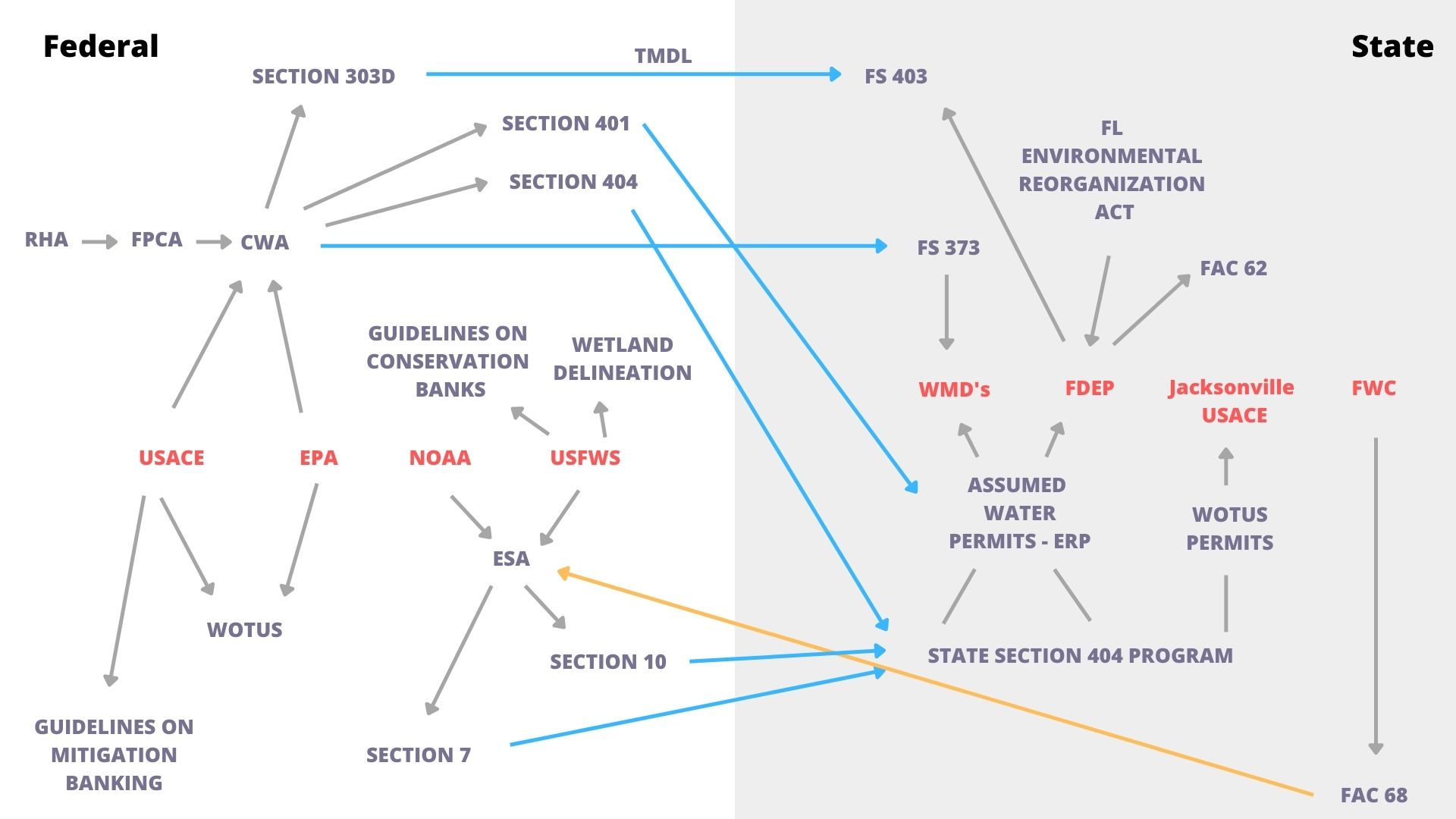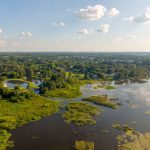The Big List of Mitigation Banking Regulations and Guidelines
When it comes to mitigation banking, we are going to break down the federal agencies and laws that create this program. A few states, like Florida, have their own Section 404 programs in addition to the federal one and details specific to the Florida program can be found over here.
Don’t skip over just yet! While Florida does have its own 404 program, it still administers the federal one as well. So, we have to know both sets of regulations when dealing with development and land use change in Florida.
How does the US government regulate the environment?
Four federal agencies run the laws and technical guidance behind water and environmental impacts. These federal bureaus have corresponding state counterparts that enforce and oftentimes expand the federal policy at the state level.
Looking at the options of what agencies may be involved (not all will be involved in each project) helps us summarize which state and federal agencies control each law for a general overview. These laws regulate the crediting market and standards for evaluating mitigation success in the mitigation banking industry.
Endangered Species Act
The Endangered Species Act (ESA) protects species of fish, wildlife, and plants that are threatened with extinction as well as the ecosystems critical to the survival of those species. Targets of the ESA are listed as critical habitats and listed species. Sections 7 & 10 affect the process of mitigation banking and permitting.
- Federal oversight: U.S. Fish and Wildlife Service (USFWS) & National Oceanic & Atmospheric Administration (NOAA)
- State oversight: Florida Fish and Wildlife Conservation Commission (FWC)
Dredge & Fill Permitting of the Clean Water Act
You will often hear about Section 404 permits, whether at the Federal or State level. Section 404 is a part of the Clean Water Act that gives the government a responsibility in where the dredge and fill of Waters of the US [WOTUS] can take place. The USACE issues periodic memorandums and regulatory guidance that update the foundations of mitigation banking.
- Federal oversight: U.S. Army Corps of Engineers (USACE)
- State oversight: U.S. Army Corps of Engineers, Jacksonville District (Corps)
Clean Water Act
The Clean Water Act was born from the Rivers and Harbors & the Federal Water Pollution Control Acts. It endows the federal government with the right to protect water quality and water use. The CWA only applies to Waters of the United States (WOTUS). Some important parts that concern mitigation banking are Sections 303(d) & 404.
- Federal oversight : U.S. Environmental Protection Agency (EPA)
- State oversight: Florida Department of Environmental Protection (DEP)
- Regional oversight: Water Management Districts (WMD)
- St. Johns River Water Management District, South Florida Water Management District, Southwest Florida Water Management District, Northwest Florida Water Management District, or Suwannee River Water Management District
Who rules on what? – Jurisdictional decision-making for mitigation banking regulations
Federal regulations only apply to Waters of the United States {WOTUS}. These are waterways under the protection of the federal government and defined roughly by their ability to be used in interstate or foreign commerce. Non-WOTUS waters fall outside of federal purview, and as such, are not regulated by the country. Therefore, the CWA only applies to WOTUS waters.
The definition of WOTUS has changed back and forth over recent years, mainly over the inclusion and exclusion of waters that do not share a surface water connection with other water. However, the Corps has regulation over Section 404 WOTUS waters and navigable waters as defined by Section 10 of the Rivers and Harbors Act.

What are they regulating for? Mitigation banking regulations to protect the environment
Water Use: Dredge & Fill Material
Section 404 of the Clean Water Act establishes a permitting program for discharges of dredged or fill material into WOTUS. Under section 404, “dredged material” has been defined as “material that is excavated or dredged from waters of the United States.”
Dredge and fill activities concern surface waters. In Florida, this includes “bays, bayous, sounds, estuaries, lagoons, rivers, streams, the Gulf of Mexico, the Atlantic Ocean, most natural lakes, and all waters and wetlands (natural or artificial).”
Water Quality: Point & NonPoint Pollution
The source of water pollution is another determining factor in jurisdiction. Federal agencies have oversight over “point” sources of pollution, like something coming out of the end of a pipe. Federal agencies regulate point pollution with Section 402 / NPDES permits.
State agencies have regulation over “nonpoint” sources of pollution, like fertilizer application, and take ownership over this water quality management with plans to restore “imparied waters” and regulate Total Maximum Daily Load (TDML).
Section 404 permits don’t deal directly with nonpoint pollution, as dredge and material is not defined in either of these categories. However, they are subject to limits of TMDL, under Sections 401 & 303 of the CWA, and wetlands serve as a great buffer for nonpoint pollution mitigation.
Florida Administrative Code 68 regulates the collection and submission of water quality standards to the EPA.
Biodiversity: Habitat Degradation & Species Loss
If development is reasonably expected to hinder a listed species’ ability to feed, shelter, and/or reproduce, it is subject to regulation by the Endangered Species Act.
Section 7 of the ESA requires that all other federal agencies, like the EPA for example, coordinate with the USFWS & NOAA before undertaking projects. This is an effort to align all government actions with habitat protection. So, USACE 404 permits should take into account critical habitat. As many species rely on water systems, the ESA and CWA regulations often overlap.
Section 10 of the ESA designates a permitting program, called Incidental Take Permits, for permission to alter a critical habitat. These ITP require a Habitat Conservation Plan for approval, and, increasingly, compensatory conservation mitigation is accepted in these plans. The FWC has a similar process for conservation banking on the state level.
The environmental agencies in charge of mitigation banking regulations
Mitigation Bank Inter-Agency Review Team
Developers and mitigation bankers are hemmed in by something called the Inter-Agency Review Team (IRT). This team is a breakdown of the federal, state, and regional agencies that decide how to administer environmental laws and will be part of the monitoring and evaluation team for the success of a bank.
The IRT for each project depends on the type of permit needed to establish a bank or impact the environment.
US Army Corps of Engineers (USACE) technical guidance on mitigation banks regulations
The USACE was given the technical right to grant permits and approve compensatory mitigation for dredge and fill activities under Section 404 of the Clean Water Act. The Corps also conducts or verifies jurisdictional determinations.
Other laws like The National Environmental Policy Act (NEPA), Coastal Zone Management Act, and the National Historic Preservation Act have additional authority over the Corps’ functionality.
- The responsibility for Section 404 was decided by a Memorandum of Agreement between the Army Corps of Engineers and the EPA. This MOA, called the Mitigation Guidance, sets mitigation standards like: mitigation sequencing, functional value assessment, and the principle of no net loss.
- Several jointly created a seminal document outlining the operations of a wetlands mitigation bank, including the creation of the IRT and mitigation banking instrument, . This document is called the Banking Guidance.
- The 2008 mitigation banking rule, referred to as The Rule, set up a clear hierarchy of mitigation banks as the preferred method of compensating for impacts. Based on a watershed approach to mitigation, this was an effort to better align policy with ecological data and, at the same time, solidified the entrepreneurial banking industry.
EPA banking regulations for wetland mitigation
The Environmental Protection Agency has overall regulation of the wetlands’ environment and the final veto right on any permits issued by the USACE. It assumed the right to make laws regarding the location of wetland fill sites under the Clean Water Act.
Alongside this right was a long list of wetland values to protect. The EPA develops and interprets the environmental data used by the Corps to evaluate permits and determine performance based credits for banks.
The agency sets standards for deciding the geographic scope of jurisdiction and together with the USACE developed the definition of WOTUS.
The EPA approves and oversees state and tribal assumption of permitting processes as related to water quality and use. They decide any exemptions to permitting rules.
Outside of Section 404. the EPA regulates a multitude of water quality and use issues under the CWA.
Conservation Mitigation banks regulations from the USFWS
The USFWS determines federal standards for wetland delineation and the official guidance on conservation banking, recognized in 2016 as a form of compensatory mitigation. Along with NOAA, the USFWS oversees the operation of the Endangered Species Act.
Some species are federally listed under the Endangered Species Act (ESA) and the responsibility of the USFWS. Other species are state-listed under Chapter 68A-27 of the Florida Administrative Code and the responsibility of the FWC.
Building on the success of a conservation banking program in California, the USFWS released its first set of guidelines on the establishment, use, and operation of conservation banks. This was solidified by a federal recognition of habitat conservation banking as a form of compensatory mitigation.
Florida State 404 mitigation banking program
At the state level, Florida Statute 373 is the counterpart to the Clean Water Act and established the five regional Water Management Districts to fulfill its statutes.
Wetlands are defined by both the Statutes and Administrative Codes, meaning permits affecting them are jointly issued by WMDs and the Florida Department of Environmental Protection.
The Florida Fish and Wildlife Conservation Commission (FWC) oversees standards in conservation banks. State agencies cooperate with the USFWS to compile an accurate list of endangered and threatened animals and their critical habitat. Florida Administrative Code 68 is set up to create this communication between the FWS & the USFWS.
In 2020, Florida assumed the right to administer the federal dredge and fill Section 404 program, taking control over permitting for these activities in state-assumed waters.
Federal and State 404 Permitting
In Florida, as a result of the state assumption of the Section 404 permitting, projects that fall under either federal or state jurisdiction file a Joint Application.
Submitting the joint application qualifies the project for review under multiple authorities and can result in an Environmental Resource Permit (ERP), a State 404 Permit, a Federal 404 permit, and/or a NPR (No Permit Required) determination.
- Projects in federally retained waters will be automatically referred to the USACE for review and issued a Federal 404 permit.
- Projects in state-assumed waters will be reviewed by the FDEP or WMD and issued a State 404 permit.
- Both the Federal and State 404 permits must first be issued an ERP before being approved. Environmental Resource Permits function as the State’s water quality stamp of approval. This takes the place of a Section 401 permit. In Florida, ERPs take into account land that falls outside of Section 404 jurisdiction, like upland habitats.
State 404 projects are not required to submit a Habitat Conservation Plan and get an Incidental Take permit (ITP). The state assumption program consulted on the Endangered Species Act at its inception, codifying guidelines and provisions for critical habitats upfront. Projects that require Federal 404 approval, however, still need to follow procedures for ITPs.
Round-Up of Key Mitigation Banking Regulations
Key Sections of Federal Laws
Clean Water Act
- Section 404
- Creates the state assumption program (Section 404-g).
- Precedent for the division of retained waters and assumed waters (Section 404-b1).
- Sets a list of exempt activities (404-f)
- Section 402
- Governs point source discharges
- Section 401
- Compliance program for effluent and water quality standards.
- Section 319(h)
- Designates funds to state agencies to implement approved nonpoint source management programs.
- Section 303(d)
- Requires states to submit a list of surface waters that do not meet water quality standards, and to establish TMDL limits for these waters.
Endangered Species Act
- Section 10
- Permit program for the incidental take of endangered and threatened species.
- Section 7
- Federal agencies must consult with the Service regarding effects of their actions on listed species and critical habitat.
Rivers and Harbors Act
- Sections 9 & 10
- Grant the USACE control over obstructions to navigable waters.
National Environmental Policy Act
Requires federal agencies to assess the environmental effects of their proposed actions prior to making decisions.
Coastal Zone Management Act
Requires that each applicant demonstrate that the proposed discharge is consistent with the state’s Coastal Management Program.
National Historic Preservation Act
Requires the Corps to consult if the proposed project may affect properties listed on the National Register of Historic Places.
Key Sections of Florida Laws
Chapter 379 State Endangered Species Act
Ch. 373 FS Florida Water Resources Act
Ch. 68 FAC Rules Relating to Endangered or Threatened Species
Ch. 62 FAC Rules Relating to Water Quality Standards and Designated Uses
The State of Florida defines wetlands in Section 373.019 (27) of the Florida Statutes, and Section 62-340.200 (19) of the Florida Administrative Code.







